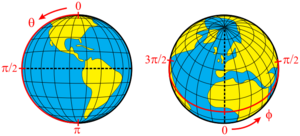Spherical coordinate system facts for kids
A spherical coordinate system is a way to describe where something is located in 3D space. Imagine you're trying to find a specific spot in a big, empty room. Instead of using "left, right, forward, backward, up, down," this system uses three special numbers. These numbers tell you how far away something is, and its direction using two angles.
Think of it like finding a place on Earth. You use longitude and latitude. These are angles that tell you how far east or west, and how far north or south a place is. A spherical coordinate system works in a similar way, but for any point in space, not just on the surface of a planet.
Contents
What Are Spherical Coordinates?
To pinpoint a location using spherical coordinates, you need three pieces of information:
- Radius (r): This is the distance from the very center of your space (called the "origin") to the point you're looking for. It's like how far a straight line would go from the center of a ball to its surface, or even beyond.
- Polar Angle (theta): This angle is often written as
 . It measures how far "down" or "up" a point is from a special line, usually the "north pole" direction. On Earth, this is similar to latitude, but sometimes it's measured from the pole instead of the equator.
. It measures how far "down" or "up" a point is from a special line, usually the "north pole" direction. On Earth, this is similar to latitude, but sometimes it's measured from the pole instead of the equator. - Azimuthal Angle (phi): This angle is often written as
 or
or  . It measures how far "around" a point is from a starting line, like measuring around the equator. On Earth, this is very much like longitude, telling you how far east or west something is.
. It measures how far "around" a point is from a starting line, like measuring around the equator. On Earth, this is very much like longitude, telling you how far east or west something is.
How Do They Work?
Imagine you're standing at the very center of a giant, invisible sphere.
- First, you decide how far away your point is (the radius). This tells you which invisible sphere your point is on.
- Next, you look up or down from a central line (the polar angle). This narrows down your search to a specific circle on that sphere.
- Finally, you spin around that circle (the azimuthal angle). This pinpoints the exact spot on the sphere.
If the point you want to find is exactly on the surface of a sphere, you only need the two angles. This is because the distance from the center (the radius) is already known – it's the size of the sphere!
Where Are Spherical Coordinates Used?
Spherical coordinates are super useful in many areas of science and engineering:
- Astronomy: Scientists use them to map stars, planets, and galaxies in the vastness of space.
- Physics: They help describe things that spread out in all directions, like sound waves from a speaker or light from a bulb.
- Navigation: GPS systems and airplane navigation use similar ideas to pinpoint locations on Earth.
- Computer Graphics: When creating 3D models and animations, especially for round objects, these coordinates are very helpful.
They make it easier to understand and calculate things that have a natural spherical shape or spread out from a central point.
Images for kids
-
The output pattern of an industrial loudspeaker shown using spherical polar plots taken at six frequencies
See also
 In Spanish: Coordenadas esféricas para niños
In Spanish: Coordenadas esféricas para niños




